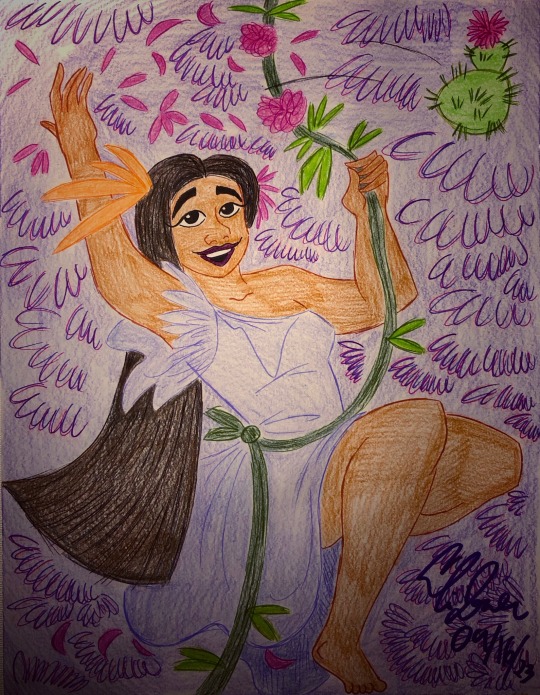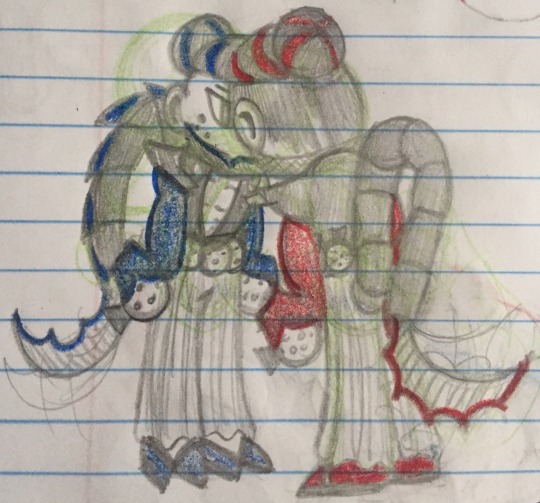#south american folklore
Text

There are seemingly endless stories across many different cultures involving visions of a giant black dog. However, it seems as though the tale is originally either Celtic, Germanic, or British. It has since expanded as far as the Americas.
Many say this creature is a manifestation of the devil, or a guardian to lead you into the underworld - but most agree that the dog is in some way or another an omen of death. Despite this grim imagery, there are some that state that the creature itself is generally harmless, and even friendly at times.
Given that this spectral dog spans many cultures, there are many different names given to the creature. Depending on who you ask, he could be "the yeth hound", "huay chivo", "capelthwaite", "gytrash", "oude rode ogen", "cadejo", and/or "dip".
#celtic folklore#germanic folklore#british folklore#south american folklore#central american folklore#latin folklore#american folklore#black dog#hellhound#tw dog#tw death#my post
5 notes
·
View notes
Text
Hey! This is for a bigger project I'm thinking of starting. If anyone could help out, I'd really appreciate it. It's kind of a turn from my usual stuff with Marvel and whatnot, but bare with me and reblog if you've got any friends/mutuals that can help out!
Calling any history/culture/mythology/folklore fans out there.
Basically, I need folklore from all different kinds of cultures, specifically personifications of things, such as Lady Justice from Greek, the Grim Reaper from Dark Ages, and Yin/Yang from Chinese.
I'm interested to hear anything and everything from all continents and countries. African, Asian, Australian, Europian, South American, and North American.
Give me the bad, give me the good, give me the ridiculous, give me the serious, give me all of it! Religious, scientific, nature, whatever!
Thanks to every participant!
#cjsinkythoughts#calling all my history buffs#folklore buffs#cultural buffs#let me hear it#history#culture#folklore#mythology#european folklore#asian folklore#african folklore#south american folklore#north american folklore#seriously just hit me#and please reblog#history tumblr#anthropology#any anthropologists out there?
9 notes
·
View notes
Text










South of Midnight, a third-person action adventure set in an original world of magic, monsters and giant, blues-playing skeletons. The game's debut trailer is a cinematic snippet introducing the protagonist, a young woman named Hazel, as she attempts to reason with an immortal specter on a dark dock. Hazel is hunting a monster — or, it's hunting her, as the trailer goes on to show — and she can wield bright threads of magic.
#South of Midnight#video game#Black American folklore#folklore#Gothic#Black goth#mythology#Hazel#Black character#Black characters#Southern culture#Black folklore#Shakin' Bones#Black American culture#magic#weaving#this looks freakin’ amazing!!#Black mythology
817 notes
·
View notes
Text
105 notes
·
View notes
Text

El Cuero from South America.
El Cuero, meaning "the hide" or "leather," resembles a primitive stingray with wide pectoral fins and a barb-less, whip-like tail. Its eyes are on stalks, and it boasts an extendable mouth akin to a sturgeon. Witnesses describe razor-sharp claws along its fringes, used to secure prey, and there are even suggestions that it utilizes hunting knives from previous victims as weapons. El Cuero's size ranges from 2 to 5 feet across, weighing approximately 65 pounds.
According to South American natives, El Cuero is dubbed the "aquatic tiger" due to its reputation as a voracious predator. Similar to a crocodile, the creature is said to surge out of the lake, overpowering its prey, often humans. It allegedly employs a proboscis to puncture the skin and extract internal organs and blood. El Cuero is said to seize individuals and animals while they bathe or cross the water, employing an irresistible contraction by folding upon itself. Using its claws, it wraps its prey, drags it to the bottom, and consumes it. The creature is described as incredibly strong, with the ability to drag a horse into the water. Despite its strength, there are claims of hunting methods involving nooses or throwing cactus chunks into the water, causing El Cuero to pierce itself.
Countless, albeit controversial, human attacks have been reported. In one account, a woman washing clothes by the lakeside claimed that El Cuero surged from the water like a crocodile, swiftly engulfing her sleeping baby. The creature then disappeared into the water as rapidly as it had emerged.
Follow @mecthology for more horrors.
Pic credit: Paranormal Strange Wiki.
Source: Encyclopaedia of Crytozoology; Cryptidwiki.
51 notes
·
View notes
Text

🌸🌺 Isabela Madrigal is still graceful as always when swinging on vines. 🌵
#Isabela Madrigal#Encanto#character study#Disney fanart#late night drawing#What Else Can I Do?#Diane Guerrero#flowers#cactus#La Familia Madrigal#We Don’t Talk About Bruno#Casa Madrigal#Madrigal Casita#South American culture and folklore#Byron Howard#Jared Bush#Colombia#Waiting on a Miracle#limitedness of perfectionism#vine swinging
35 notes
·
View notes
Text
hi sorry ive never been to disneyland SPLASH MOUNTAIN IS BASED ON SONG OF THE SOUTH?????
this is probably one of those things that most people know because its so popular but jfc WHY
#whats even the thematic connection#ive watched song of the south#it doesnt particularly have any water in it#im ASSUMING the ride is based on like. just the folklore bits right#not the weird intensely boring wildly racist live action bits?#cause i know disney keeps trying to repackage those cartoon bits and divorce it from the racism but tbh theyre pretty not great too#its a white racists idea of african american folklore its hardly well represented
46 notes
·
View notes
Text
A few (primarily Southern) superstitions I found while doing an Antrho project. Most of these are from my family's history, but a lot of them are also just very common Southern superstitions that I thought were cool.
The first male to enter the house after the New Year has to give the family a dollar, which has to be taped above the front door indicating that money will flow throughout the house for the new year. According to my mother, this comes from a side of the family that she believes was Polish. She's not sure if that's true or not, but my grandmother on that side did this every New Year's until she died.
Eating black-eyed peas, collard greens, and pork on New Years brings good luck. This one's very common and my family does this every year (my parents cut out the collard greens, but my grandmother keeps them in. She also uses hog jowl instead of regular pork). The peas are for luck, the greens are for money, and the pork is for prosperity.
Putting a mirror on your porch can prevent the devil from entering your home. Basically this comes from the idea that the devil can only enter a house at night and must return to hell at sunrise and by placing a mirror on your porch, his vanity will cause him to spend the entire night looking at his reflection until the sun comes to banish him.
If you plant a cedar tree and it grows to be six feet tall, you'd lose someone close to you. This one comes courtesy of my grandfather and was honestly one I'd never heard of before.
To prevent spirits from entering your house, paint the entryway/porch of your house with haint blue to confuse them since spirits can't cross water. You see this a lot here and mainly it's the porch roof that's painted haint blue, but I've seen doors and shutters also painted this way.
If you have cracks in your house, a boo hag (a trapped spirit that kind of acts like a vampire) can use them to enter your home. Boo hags mainly use a person's breath as sustenance instead of blood, and it's believed that if the person being fed on by a boo hag struggles, the hag will just take their skin. The hag also has to return to their own skin (as when they feed at night they have none) by morning or else they will be trapped forever without skin.
Having a bottle tree can ward off evil spirits. This is the same thing as painting your porch haint blue, except you hang blue bottles on a tree instead. A lot of people have these regardless if they believe the superstition and they're honestly really beautiful.
#this place might be a waking nightmare sometimes but god does it have some interesting folklore#like when I'm able to ignore all the horrible things that happen here it makes me genuinely happy live here#I've got a whole book based on ghost stories from here that I need to share sometime as well#the only one of these that didn't come from my family was the one about the bottle trees#but those are so common here that I included it anyways#I also just really love bottle trees#I'm trying to see the positivity more in my culture and heritage and I'm slowly beginning to learn to be more proud of who I am#it's a lot of personal negativity to try to push past but I'm getting there#american south#deep south#appalachia#meso's musings
18 notes
·
View notes
Text
theres so little time and so much i want to KNOW about other histories and cultures.... why can't i just have the income and time to take classes to learn about them.
Hell, to learn ASL!!! I WANT TO KNOW SO MUCH. But my adhd addled brain needs things to be presented well else i wont. It turns into an impenetrable meat wall.
#furiously adding books to my cart about my interests#i WANT to know about south american culture and history!!#the history of textiles!!#about india and its history and culture!!#SO MUCH FOLKLORE#FROM EVERYWHERE#I WANT TO KNOW ALL THE INTERESTING THINGS DAMN IT#mun talk
4 notes
·
View notes
Text
i love combining so much mythology and history into my books lore because it creates such an interesting historical dynamic and character interactions ❤️❤️
#years ago it was just greek shit#now we’ve got celtic myths west african tradition native folklore south american creatures#i’ve done so much random research over the years that in my brain it’s just like#“oh yeah of course this all makes perfect sense’’
2 notes
·
View notes
Text
Deadly fall: The Grim Reaper
THE GRIM REAPER
Category: World culture / World mythologies
Everybody knows that, when it comes time to personify or embody the concept of Death in fiction, the Grim Reaper appears. Everybody knows what the Grim Reaper looks like: a skeleton dressed in a black robe or cloak with a hood, wielding a scythe, coming to collect the soul of a deceased or to “cut” the life of a person to cause their death.
But while this image is considered to be “universal” today, it wasn’t always the case. In fact, the very concept and idea of a Grim Reaper was conceived in England! In Europe, death as a concept and manifestation was always represented in art through skeletons. Moving, animated skeletons – even dancing skeletons in the case of the “Danse Macabre” motives. These skeletons were often draped in shrouds (which later caused the “white sheets” of the ghosts), but due to black being a color more associated with death, soon the embodiment of death came to be seen as wearing capes or cloaks of this color. Death in particular was VERY personified in England, where he was a traditional character of morality plays as well as of folk songs – but then, Death was only known as “Death”, nothing else. We would have to wait for 1847 and “The Circle of Human Life” for the term “grim reaper” to appear, describing dying as “meeting the grim reaper with his scythe”. Later, the expression became so popular it evolved into the “proper name” of the character, Grim Reaper.
Why a scythe, you might ask? Well originally speaking, it all dates back to Greek mythology. There is the characters of Kronos, the king of Titans and father of Zeus, who was depicted as holding a scythe – he had used it to emasculate his own father (long story). Kronos was turned by the Romans into Saturn, a god of agriculture and fertility, and the scythe symbol was kept. Already depicted as an old man, to show the “ancientness” of this deity, there also came to be a confusion between “Kronos” (the god’s name) and “Chronos”, which is the Greek word for time – this resulted in the well-known figure today of “Father Time”. Kronos devouring his own children to avoid being overtaken was completely counter-interpreted as “Time devouring all” and “Time destroying youth”. And soon, due to a displacement between Time and Death, the scythe of Kronos/Saturn was given to Death, who “reaps” the human souls when they are about to die the same way a reaper reaps the crops once the harvest is ready to be taken. But before the scythe was settled as THE weapon of death, many other instruments and tools were used: you can see medieval depictions of Death showing him wielding swords, spears or pitchforks.
I say “he” because the English language and tradition masculinized Death, something that Germany also did – but it should be remembered that in Latin-speaking countries of Europe, such as France, Spain and Italy, “death” is a female word, and by extension could often be depicted as a female entity. A last inspiration for the formation of the Grim Reaper figure should be mentioned: the Bible. More precisely the Book of Revelation (The Apocalypse). When describing the four horsemen of the Apocalypse, the last one is said to “ride a pale horseman”, and that his name is “Death”. This image of Death as a pale horseman struck DEEPLY popular imagination, which explains why Death is now often seen as a “pale rider”, or as riding a white horse. But again, it is a bit of a twist – as the “pale” of the original text did not mean “white” like people think today, but rather it designated a greenish color, “chloros”, a bit yellow on the side, meant to evoke the color of rot and of a corpse’ putrefaction. The name however was correctly translated as the text says the rider’s name was “Thanatos”, which is the Greek word for Death (as well as the name of their own death god), and the Biblical text even hit the nail even more by adding “and Hades followed him”. It is usually translated as “and Hell followed him”, but “Hades” in Greek was a more neutral word who simply designated the underworld and afterlife in a general way – and even could be used figuratively to talk about a tomb or a grave.
Once the picture of the scythe-wielding skeleton was settled, it quickly spread to the rest of Europe, often replacing local death incarnations.
For example, in Scandinavia the traditional Grim Reaper replaced “Pesta”, a supernatural hag in black hood embodying the plague (she was a death entity that was created during the times of the Black Plague). A descendant of the Norse goddess Hel, Pesta was said to wander into towns with either a broom or a rake, to collect the souls of her victims: if she had a rake, some people in the town would survive, like leaves escaping a rake; but if she had a broom, she would forget and spare no one. But when the Grim Reaper arrived, poor old Pesta was quickly forgotten: in fact, it is from Scandinavia that came to us one of the most memorable and influential depictions of Death on a cinema screen. “The Seventh Seal”, the Swedish film by Bergman. Lithuanians also had their own female incarnation of death replaced by the traditional Grim Reaper: they had the goddess Giltine, an ugly old woman with a long blue nose and a tongue covered with a deadly poison. Interestingly, according to their myth, she used to be a pretty young goddess, and a very pleasant person, but spending seven years locked in a coffin turned her into the monster she is today: meanwhile her sister, Laima, kept her charm, beauty and pleasantness – and she was the goddess of life, destiny, childbirth, marriage and luck.
Of course, while the Grim Reaper figure spread everywhere, it still has numerous local variations (it is Europe after all).
For example, in the French region of Bretagne there is the Ankou (see my posts about him). In Poland, the Grim Reaper is dressed in white, not black, and given their word for death is female (“smierc”), he tends to be a she, a skeletal old woman. In the Netherlands, Death is known as “Magere Hein” (Meager Hein) or “Pietje de Dood” (Peter the Death). And in many European countries, one will note that the behavior of Death or the names given to Death will correspond to those attributed to the devil – as often the fear and hatred of death led people to fuse together or confuse the figure of the devil and the one of the grim reaper.
- - - - - - - - - -
A fascinating study of the “Grim Reaper figures” would be the one of Death in Latin America. They have here a very rich series of cultures with very unique interpretations mixing the traditional Grim Reaper imagery with Christian religion. Three main entities come to my mind, all “folk saints” (saints that are not recognized by the Church in any way, but that exist in popular worship and in folklore):
# San Pascualito in Guatemala. The “King of the Graveyard” as he is called, San Pascualito Muerte appears as a skeleton in robes, or a skeleton wearing a crown, often with a scythe. A distortion of the cult of the actual saint known as Paschal Baylon, beyond a cult of death he is invoked and prayed to cure diseases and appease epidemics. His feast day is said to be the 17th of May, and he is usually given candles of different colors depending on what you ask him for (red for love, pink for health ; dark blue for work, light blue for money ; black for revenge, white for protecting children, etc…)
# San La Muerte. Mostly worshiped in Paraguy, with also a presence in north-eastern Argentine and southern Brazil (plus Buenos Aires). “Saint Death” appears as a skeleton with a hooded cloak (usually black and red) wielding a scythe (with sometimes blood on the blade), and is sometimes called “Señor de la Muerte” or Señor de la Buena Muerte, even “San Esqueleto” (Saint Skeleton). Like the previous saint, in exchange for prayers and offerings (one’s own blood, alcohol or precious objects) San La Muerte offers a variety of services : restore love, fortune or health, protect from witchcraft and remove the evil eye, offer good luck when gambling… But unlike San Pascualito, San La Muerte also has an active cult in prisons due to the saint also offering favors related to crime and violence: he can avoid one going to prison, shorten prison sentences, or cause the death of an enemy. Often invoked by brujas (witches) and curanderos (folk healers), San La Muerte’s feast day is the 15th of August.
A very “pagan” element of San La Muerte cult is the fact that the statues of his are the center of said cult, and treated as physical manifestations of the saint. They are consecrated by Catholic priest seven times to become “true” incarnations of the San (and since the Church disapproves and reject San La Muerte, people tend to hide the statue under the image of another saint to get the blessing anyway). These statues are kept on altars and “fed” with the offerings – families usually keep them hidden in their household for the San to bring protection over their families. When someone is favored by the San, they can pass on their protection to another person by giving them their statue of San La Muerte. It is also believed that if the statue is made of special materials, it will be more “powerful”: thus you have San La Muerte statues made out of baby bones, of Christian man bones, of coffin woods, carved in the crucifix that belonged to deceased… Same thing works for various amulets made of bullets (usually those that killed a man, especially a Christian man). These amulets, and tattoos or carvings of San La Muerte in the skin, are said to protect from bodily harm and imprisonment. And unlike other saint cults where you ask, beg, request favors from a saint, in the cult of San La Muerte, you have to “threaten” the saint: you threaten the statue with “hunger” (no offerings) or with “solitude” (banishing it to a dark corner of the house) in exchange for its favors, and once the San grants the favor you “reward” him through his statue (but not too much, as you must keep him “starving” for him to be open to a new deal).
# Santa Muerte is the Mexican manifestation of the “death cult” of Southern America. Santa Muerte (Holy Death/Saint Death), also known as “Our Lady of Holy Death”, Nuestra Señora de la Santa Muerte, is a female folk saint acting as the embodiment of death – a female skeleton with a long robe, holding a scythe and a globe. She is not like other saints a dead human: she IS death itself, taking shape: while the scythe is the typical tool represent her job of cutting the thread of life, the globe represents her dominion over all of earth. Despite her grim appearance, Santa Muerte is actually a benevolent entity who offers healing, protection, financial wellbeing, and a safe travel to the afterlife. Worshiped clandestinely until the 1990s, since then she became a popular public figure. Other attributes of her include the lamp (that she uses to guide us through the darkness, figuratively or literally), the owl (that acts as her messenger), the scale (that represents the divine justice and the equity and impartiality of the will she enacts), and the hourglass (typical Grim Reaper symbol, representing the limited lifespan of a human life – another heritage that the Grim Reaper got from Father Time). Her cult is informal and unorganized, going from a clandestine cult to a highly popular and fast-spreading trend: most people have home shrines dedicated to her, there are special votive candles of different colors to invoke her various favors ; similarly statues of the Santa Muerte are dressed in different colors to pray for different things (white for gratitude, purity and cleansing ; red for love and passion ; green for justice and legal matters ; gold for money, prosperity and economical success…). She receives a special sub-cult as “Señora de la Noche”, Lady of the Night, by those exposed to the dangers of working at night (taxi drivers, bar owners, prostitutes, policemen…). Her feast day is either the 1st of November or the 15th of August depending on which area you are. Santa Muerte got for a time a bad reputation due to being one of the favorite saints of drug dealers, with her cult spreading to prisons (both among inmates and staff) and her prayers being tied to violent and illegal businesses ; but more recently, she also became the protectress of homosexuals, bisexuals, transgenders, and other queer people of Mexico due to them being outcasts of Christian religion and Mexican society, and Santa Muerte precisely being a non-conforming saint like them: her image is notably used during same-sex marriage ceremonies.
All these folk saints are part of the wider “cult of death” prominent across most Southern America cultures, a cult that is HIGHLY rejected by the Catholic Church, despite these folk saints precisely being created to fit in a Catholic context. It is not so much because they are fictional, or because some of them are clearly “pagan” practices (see San La Muerte), but it is rather because their very existence contradicts the fundamental teaching of Christianity – the one of Resurrection. Through Resurrection, Christ is the one who defeated and vanquished death, and the promise of Heaven by God is the one of an “endless” and “eternal” “true life”, going well beyond our limital physical existence ; the Christian doctrine does insist on death being simply a temporary state, and during Judgement Day, at the end of time, death will be erased as all will be resurrected to live in a state of eternity.
All this concept of death as a temporary thing or a vanquished power, by nature, cannot fit with the worship of death as a saint or holy concept in itself.
#deadly fall#grim reaper#santa muerte#psychopomp#death cult#south american religion#european folklore
36 notes
·
View notes
Text






Sniper: Um...whatcha got there?
Beastmaster, with Xoco glaring at the merc by the door: a smoothie
#team fortress 2#oc#tf2 oc#the chemist#the pilot#the beastmaster#my art#yes I tweaked the beastmaster’s design and completely changed Xoco#xoco is now based on the tuyango which is a bird from south american folklore#rip to the mouth limbs tho :(#two chemists of the RED and BLU teams meet and begin asserting dominance like cats
8 notes
·
View notes
Text
Hey folks that live in the American Deep South and/or Appalachia tell me your urban legends/folklore/myths/superstitions please
I just think they’re neat and would like to collect them I want to put the American south under a microscope
3 notes
·
View notes
Text


Milena Warthon, a rising singer/artist in the Andean-pop genre 🌬️🌠⛰️💜
#Milena Warthon#Andean pop#Andean indigenous#andean#mujer andina#Native south american#Andean textiles#Huayno#folk singer#folklore singing#indigenous to peru#indigenous to south america#native american#native singers#ndn tumblr#Apurímac#Apurímac peru#Apurimeña#singers#rising singers#native american singers#native american diaspora#peruvian#indigenous peruvian#Ancash Peruvian#ancashina#Ancash peru#andean women#andean woman#andean singers
8 notes
·
View notes
Text

🌸🌵 Isabela Madrigal and a cactus 🌵
#Isabela Madrigal#Encanto#character study#Disney fanart#La Familia Madrigal#What Else Can I Do#Surface Pressure#We Don’t Talk About Bruno#Mirabel Madrigal#flowers#cacti#cactus#Diane Guerrero#Colombia#La Casita#La Casita Madrigal#Luisa Madrigal#South American culture and folklore#Once Upon A Studio
15 notes
·
View notes
Text
Top 15 Games that Need a Remake (2023 Edition)
I saw that GameBolt made a video about this topic, but I found it kind of dull to watch. It had ALL of the usual suspects on there from videos that other channels have made. I made a list like this about 8 years ago, and I thought to myself – why not actually look at this topic again? Find games that aren’t just a few years old to ask if we could get a sequel to them. Especially since some of…

View On WordPress
#Alice#American McGee#Black#Dead Franchises#Devil May Cry#DmC#Folklore#Fuck EA#Gaming#GamingBolt#Halo 3#Madness Returns#MediEvil#ODST#Panzer Dragoon#Rogue Squadron#Sequels#Shards of Darkness#Skies of Arcadia#South Park#Star Wars#Stealth Assassins#Styx#Tail Concerto#Tenchu#The Fractured But Whole#Twisted Metal#Video Games#X Men Legends
0 notes